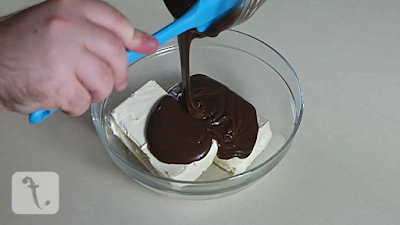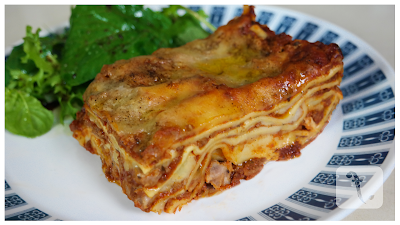2.12 Lasagne – Advanced – Rice & Pasta
Okay, okay. I know some of you are saying or thinking
“but why has he listed LASAGNE as ADVANCED???”. Well, to put it into
perspective, you need to make a Bolognese sauce and a Béchamel sauce (both of
which are either time consuming or fussy), then assemble everything and bake it
for the right amount of time. The full recipe can take more than 3 hours from
beginning to end.
Advanced doesn’t necessarily mean “difficult”, but
there’s more to it than throwing a few jars of sauce at some pasta sheets and
shoving the whole thing in the oven!
ALSO - This is the final episode of Season 2. I'll be back with Season 3 on 2nd October 2015, but there'll be a couple of bonus recipes before then.
PART A – BOLOGNESE SAUCE
As usual, I don’t know how traditional this is as nobody
taught me how to make it. You can use this sauce over some pasta if you don’t
feel like going the full Lasagne route.
Ingredients:
400g Italian pork and fennel sausages, removed from
casings
500g lean beef mince
2 large red onions, diced finely
3 large garlic cloves, minced
800ml passata
500ml beef stock
200ml boiling water
150ml red wine
¼ cup chopped fresh oregano leaves
½ cup chopped fresh basil leaves
2 tbsp tomato paste
½ tbsp black truffle salt (see notes below)
Pepper
Olive oil (for frying)
I have specified Italian pork and fennel sausages. This
is because they seem to have a higher percentage of meat when compared to other
sausages, plus the flavours work. If you want to use plain pork sausages (or
another flavour you like), then go right ahead. If you want to get rid of the
pork completely, then I guess beef sausages could work, or just use extra mince.
I would recommend lean mince in this as there’s probably
already going to be a bit of fat in the sausages, plus you’ll need to add some
oil for frying. You can use ordinary beef mince (I usually do), but if you want
to get all fancy, feel free to use Angus or Wagyu beef instead. Traditionally,
you should be using veal mince anyway.
Passata is just a smooth tomato puree. If you can’t get
it, blend a few tins of tomatoes until smooth.
The type of wine doesn’t matter. Just use anything you
have laying around. I’m not really a wine connoisseur.
If you can’t get fresh basil and/or oregano, use 1 tbsp
dried oregano and/or 2 tbsp dried basil instead.
I use truffle salt to add a hint of additional flavour. If
you don’t like truffles, don’t worry, you can substitute it with plain salt and
still have a great lasagne. Or, you could use another type of specialty salt,
such as smoked sea salt, black sea salt, pink salt, etc. Not all salt tastes the same. You
could even drizzle some flavour-infused oil over the top when you serve it.
Method:
1. In a large pot over medium-high heat, fry the onions in
some olive oil with a generous pinch of salt until softened, then add the
garlic and fry until browned.
2. Add the sausage meat and cook until browned. (Try to
break up the meat as much as possible.)
3. Add the beef mince and cook until browned.
4. Stir in the red wine and allow to simmer for approx.
30 seconds to remove some of the alcohol.
5. Stir in the tomato paste, passata, stock, water,
chopped herbs, truffle salt and a generous pinch of pepper. (TIP: I would usually pour the water
into the empty passata bottle and shake it up to get anything stuck to the
sides.)
6. Once it comes to a simmer, reduce heat to low and
cover the pot.
7. Simmer sauce for 2 hours, stirring every 15-20
minutes. (You don’t need to be too diligent here. Leave the sauce to do its
thing, just go check on it from time to time. You don’t want the sauce to be
too thin, but you also don’t want it to be too thick as the pasta sheets will
absorb some liquid as it cooks later.)
8. Once the sauce is done, put aside until you are ready
to assemble. (Like all Bolognese sauces, this gets better if you leave it in
the fridge overnight. Just heat it up a bit before you use it to make it easier
to pour and spread.)
Makes enough for 1 Lasagne, or several serves of
Spaghetti Bolognese.
A video of this part of the recipe is also available - https://youtu.be/lATn05YwnTI.
PART B – BÉCHAMEL SAUCE
A fairly standard white sauce. Of course, I have to mess
with it a bit (it’s kind of my thing), but I don’t go too crazy with it.
My mother tells me that adding cheese to a Béchamel sauce
makes it a Mornay sauce (and from what I can see she's correct), but I don't think I add a large enough amount of cheese to make the distinction. If you have to, then call
this a Mornay sauce. Or a Béchamornay. Whatever!
Some people like to use ricotta in their lasagne instead
of Béchamel. They are to be pitied.
Ingredients:
1L milk
100g unsalted butter, cubed
½ cup plain white flour
1/3 cup grated parmesan cheese
½ tbsp black truffle salt
½ tsp pepper
Extra milk (if necessary)
The truffle salt is back again! As before, feel free to
substitute it for another salt.
You may not need the extra milk, it depends on how thick
you want the sauce.
Method:
1. Over a medium heat, melt the butter in a pot.
2. Once it is bubbling, add the flour and whisk until
combined. (This is called a ‘roux’ (pronounced “roo” for those of you who are wondering).)
3. Continue to whisk the butter and flour over the heat
until the roux begins to darken to a light nut-brown colour. (Be careful, you
don’t want it to burn.)
4. Pour in the milk and whisk constantly until the sauce
has thickened to a custard-like consistency and remove from the heat. (The
longer it cooks, the thicker it will get.)
5. Whisk in the parmesan cheese, truffle salt and pepper.
6. If mixture thickens too much, add extra milk as
necessary until proper consistency is retained.
7. Place aside until you are ready to assemble.
Makes enough for 1 Lasagne.
PART C – ASSEMBLING THE LASAGNE
Ingredients:
approx. 12 Fresh Pasta sheets
3 cups Mozzarella cheese, grated
½ cup Parmesan cheese, grated
Black truffle salt (optional)
Pepper (optional)
There is no real art to this. The amount of each of the
above ingredients used is really up to you, and depends on the size, height
and depth of your baking dish, as well as how generous you are with the Bolognese
and Béchamel.
Fresh pasta sheets seem to work much better than dried,
and do not take as long to cook in the oven. If you feel more confident with
dried pasta sheets, then use them instead, but don’t blame me if it doesn’t
work out the same!
Method:
1. Preheat oven to 180°C (360°F).
2. Pour a generous spoonful of the Bolognese sauce into
the bottom of your baking tray and spread it to the edges. (This gives the
first layer of pasta something to rest on and stops it from sticking to the
pan.)
3. Place the pasta sheets in a single layer over the
Bolognese. (Try not to overlap. TIP: If
there are any large gaps, just cut or tear an extra pasta sheet into strips to
fill the gap.)
4. Pour another couple of spoonfuls of Bolognese over the
pasta and gently spread to the edges of the dish.
5. Pour over 1/3 of the Béchamel sauce as evenly spread
as possible. (Don’t be too concerned if it doesn’t look even, you can press
down on the next layer of pasta sheets to spread it out.)
6. Scatter a small handful of mozzarella over the Béchamel.
(Optional – you need to have enough Mozzarella leftover to cover the top layer,
so be a bit stingy with it between the layers.)
7. Repeat Steps 3-6 as necessary.
8. Once the dish is full, scatter over as much
mozzarella, parmesan, truffle salt and pepper as you’d like.
9. Bake for 45 minutes. (The pasta sheets should be
cooked by now.)
10. Allow to cool for 5-10 minutes, and then serve. (A
simple garden salad goes well with this.)
I’ve made this for a broad range of people, and based on
this experience it can serve anywhere from 6-12.
A video of this part of the recipe is also available - http://youtu.be/Rz2FOAWQ36g.
I hope you've enjoyed Season 2, and I'll see you again soon!























